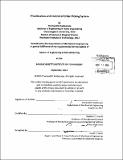Prioritization and control of order picking system
Author(s)
Kanburapa, Prachyathit
DownloadFull printable version (15.29Mb)
Other Contributors
Massachusetts Institute of Technology. Department of Mechanical Engineering.
Advisor
Stephen C. Graves.
Terms of use
Metadata
Show full item recordAbstract
Order Picking System (OPS) efficiency at a warehouse was studied with the goal of reducing production order lead time to 8 hours. Current material flow system and strategy were studied through interviews with personnel involved. In addition, data extraction and analysis were performed using the company's SAP Extended Warehouse Management (EWM) database to analyze the past performance in the warehouse. Three areas for improvement are recommended. First, updating the Vertical Lift Module (VLM) picking machine to operate in the First-In-First-Out manner will solve the picking idle time in other areas with an expected average time savings of 20 minutes per part. Second, integrating a signal to notify pickers when there are pick tasks outstanding in the areas will both reduce picking time lag and prevent the parts from staying overnight. Lastly, implementing the correlation-based storage assignment to store parts that are usually ordered together in the same vicinity is expected to saves 72 minutes of picking time a day on average. These recommendations are to be combined with other material flow improvements. It was determined that the goal of 8 hours lead time is unrealistic. However, calculations suggest that lead time will be reduced to 16 hours.
Description
Thesis: M. Eng. in Manufacturing, Massachusetts Institute of Technology, Department of Mechanical Engineering, 2013. Cataloged from PDF version of thesis. Includes bibliographical references (pages 82-84).
Date issued
2013Department
Massachusetts Institute of Technology. Department of Mechanical EngineeringPublisher
Massachusetts Institute of Technology
Keywords
Mechanical Engineering.